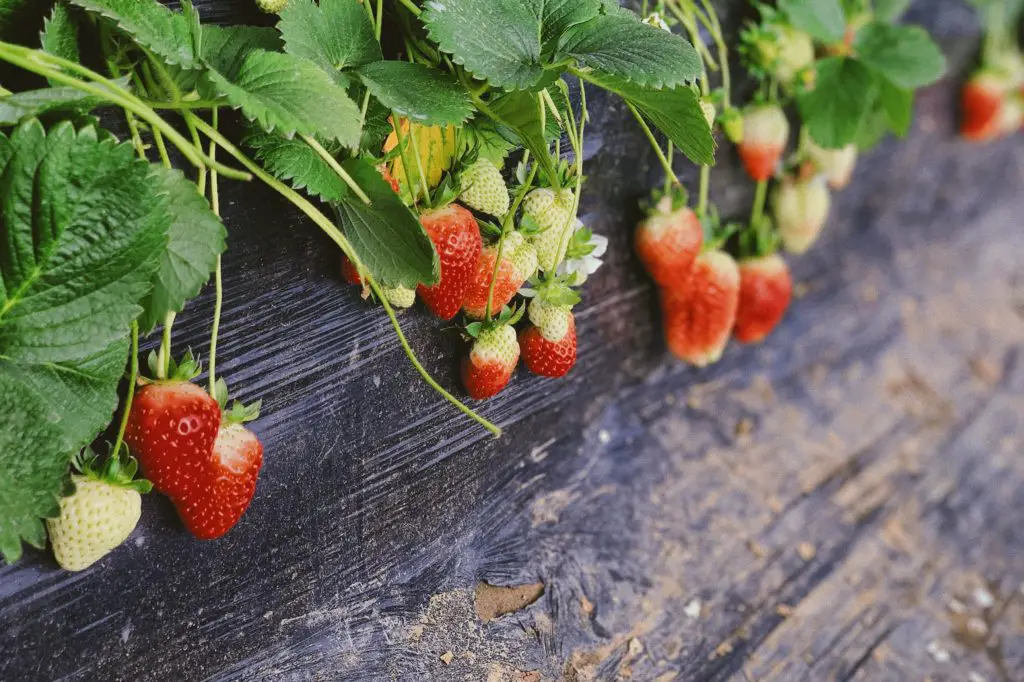Nothing in the yard gets my kids as excited as growing and picking strawberries. They are perennial plants and are one of the first fruits of the year in my area, which adds to the anticipation. They can be grown in home gardens, raised beds, or even pots, and are very easy for the kids to water, harvest, and eat. The biggest drawback that my family has experienced in growing strawberry plants is that the rabbits like them just as much as we do, and often eat the fruit before we can harvest!
How Much Water Do Strawberry Plants Need?
Strawberry plants have fairly shallow root systems, which causes them to dry out in a relatively short amount of time. Therefore, strawberry plants need regular watering. While the strawberry plant is young and not yet producing fruit, it will need about one inch of water per week. During the hot and dry summer months, you may need to increase this amount to 2-3 inches per week.

When flowers begin to appear on your strawberry plants, this is a signal that they are preparing to produce fruit, which should happen approximately three to four weeks later (read the section below that explains the three different types of strawberry plants and the times of year that they produce fruit). During this time, watering the plants is especially important to make sure that you are getting the most berries possible out of your plants. During the period before and during fruiting, plants will require an average of one to two inches of water per day.
Finding the correct balance of water and a consistent watering schedule will directly impact both the quantity and quality of your strawberry harvest. If your plant is underwatered, it will produce far less fruit than a plant with enough water.
Overwatering can impact the flavor of the berries and can also lead to rot in your strawberry plants. It is helpful to check the soil moisture weekly by sticking your fingers roughly two inches down into the soil. It should feel moist. If you are growing strawberries in pots or containers, you will need to check the soil more frequently. The soil in pots will dry out faster than the ground or raised beds.
Because strawberries are perennials, they will experience a dormant period and then return each year of their lifespan when temperatures start to rise. With this in mind, remember that younger plants will need less water than older plants, as they can hold water more effectively.
What is the Best Watering Method for Strawberries?
Planting your strawberry plants in raised beds will promote better soil drainage. However, I’ve found that the berries do just fine when planted directly in the ground, as long as I am mindful of the amount of water they receive.
Whether in the ground or in raised beds, drip irrigation is best, because strawberry plants can rot if the leaves sustain continually wet conditions. But if you’re like me and haven’t made that kind of commitment to your berries, you should water in the morning so that the plant has enough time to dry out before nightfall. Do this by soaking the roots with a trickle from your hose and try to keep the leaves relatively dry.
A distinction must also be made in the type of strawberry plant that you have so that you know when to expect the plant to flower and bear fruit. There are three types of strawberry plants:
- Everbearing strawberries will produce fruit twice each year (once in early summer and again in early fall).
- Day neutral strawberries can produce fruit all year long. These plants require watering throughout the summer, from spring months into October.
- June strawberries, or June-bearing strawberries, produce one more bountiful harvest of fruit in early summer.
How Can I Help My Strawberry Plants Preserve Moisture?
Strawberry plants need approximately six to eight hours of sunlight each day and thrive in very sunny conditions. This love of sunlight must be balanced, however, with the recommendations for watering discussed above, as well as methods to help your plants preserve soil and root moisture throughout the year. One method is to plant a small layer of mulch around your strawberry plants during the hot, dry months of the year, to help the soil retain moisture.
Try to keep up with the weeds around your berry plants to reduce the competition for moisture and nutrients. Remove dead or dying leaves as you spot them to create more space for new foliage growth.
It is also helpful to mix fertilizer, such as an all-purpose plant food, into the soil before you plant strawberries.
Do I Need to Water My Strawberry Plants in the Winter?
Once you’ve harvested your last berries of the growing season, your plants will need some minimal care to make sure that they survive the winter and come back strong the following spring. You can begin by pruning their foliage and stems to a couple of inches from the ground and pulling any weeds surrounding the plants.
You should continue to water your plants as directed earlier in this post until you begin to have frosts at night. In most growing regions of the U.S., minimal water is needed during the winter months when the strawberry plants are in a dormant phase. You should check the moisture level periodically by feeling the soil with your fingers two inches below the surface to make sure the soil feels slightly damp and not dry and crumbly.
If you live in an area where the ground freezes during the winter months, cover your strawberry plants with straw or additional mulch.
How Often Should I Fertilize My Strawberries?
In my area, the local cooperative extension recommends fertilizing a few weeks before planting, and then again four to six weeks after planting. There are fertilizers specifically formulated for various types of berry plants. However, any type of all-purpose fertilizer for acid-loving plants should work well.
